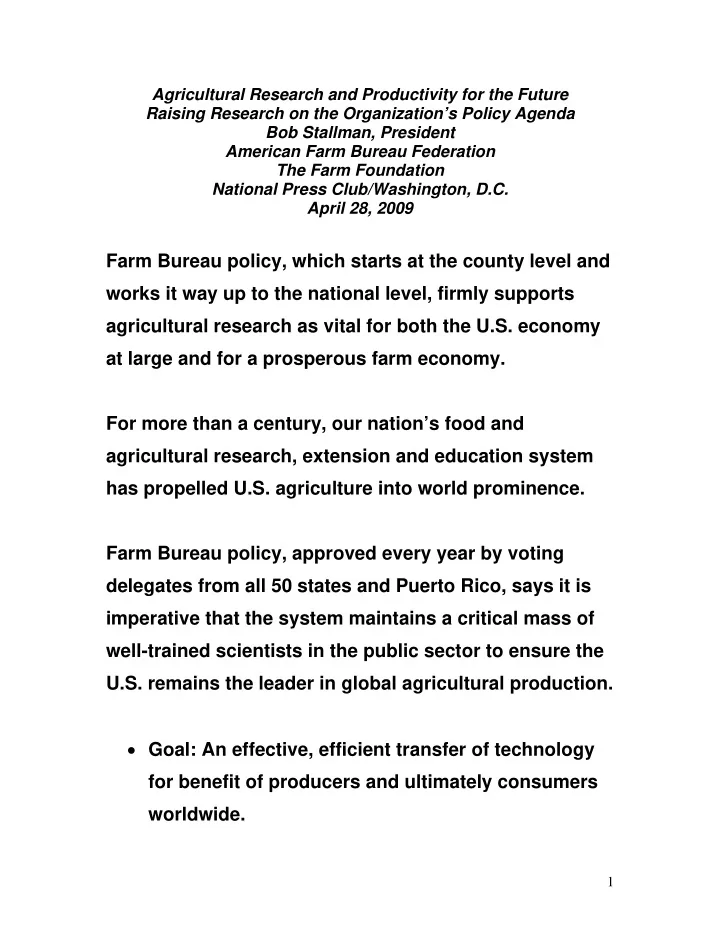

Agricultural Research and Productivity for the Future Raising Research on the Organization’s Policy Agenda Bob Stallman, President American Farm Bureau Federation The Farm Foundation National Press Club/Washington, D.C. April 28, 2009 Farm Bureau policy, which starts at the county level and works it way up to the national level, firmly supports agricultural research as vital for both the U.S. economy at large and for a prosperous farm economy. For more than a century, our nation’s food and agricultural research, extension and education system has propelled U.S. agriculture into world prominence. Farm Bureau policy, approved every year by voting delegates from all 50 states and Puerto Rico, says it is imperative that the system maintains a critical mass of well-trained scientists in the public sector to ensure the U.S. remains the leader in global agricultural production. • Goal: An effective, efficient transfer of technology for benefit of producers and ultimately consumers worldwide. 1
o AFBF backs basic and applied research and technology transfer to the benefit of U.S. farmers, ranchers and consumers. • Partnership is critical for success in research, between USDA’s Agricultural Research Service and land grant and other universities, private sector and producers themselves. Key to success for the past hundred years. • Farm Bureau supported creation of NIFA (National Institute of Food and Agriculture) in the 2008 farm bill. It should help set priorities for national agricultural research and hopefully make ARS and the land grant universities work better together. • American Farm Bureau states that cooperative research programs should reflect and be tailored to the unique, soil, environmental and socioeconomic makeup of regions, states and locales. • We also believe that programs should be incrementally funded above the rate of inflation. 2
• AFBF values and appreciates the work of ARS. Farm Bureau policy states that the ARS budget be maintained at levels no lower than the 2008 budget appropriation. • Golden Age of agricultural research began in the early 1950s, the result of an expansion of public support for the sciences following World War II. o U.S. led the world in agricultural research. Advances were disseminated around the world through public and private channels. o This was the Green Revolution we all know about. o Changes in this model began in 1960s and became more pronounced beginning in 1980s as private sector agricultural research developed. 3
• According to USDA report released in March, real agricultural research spending --- from all funding sources, adjusted for inflation --- fluctuated but remained basically level from 1980 through the mid- 1990s, then fluctuated. • In the late 1990s, state Experiment Station from Federal sources outside of USDA as well as non- Federal sources continued to increase. Federal intramural funding of ARS research leveled off. • Farm Bureau supports increased ARS funding support to state Experiment Stations. o State Farm Bureaus are advocating for more research funding for their state’s land grant institutions. • Farm Bureau also supports farmer check-off dollars to be targeted to agricultural research. o As a rice farmer in Texas, I pay an 8 cent per hundredweight checkoff for market 4
development and research. Three cents of checkoff goes to market development through U.S. Rice Producers Association ands 5 cents goes to research at the Texas Agricultural Experiment Station in Beaumont and Eagle Lake. o This farmer checkoff has been critical to success of rice research in Texas. Checkoff program helps agricultural research in other rice growing states and for other commodities as well. • For farmers, support for federal funding of agricultural research is a mile wide and inch deep. o A farmer in a tight budget situation is not willing to reduce his direct payments or loan rate or target price to increase support for research. 5
• On federal level, if we mandate agricultural research in farm bill, members of Appropriations Committee will earmark funds for whatever research project is in their district, so support will wane because it is not for big picture. • In many ways, farmers are victims of their own success. o Over the past 100 years, there have been many successes in agricultural research. Farmers have taken it for granted and haven’t even thought about it. • Also, the demographic shift to large operations that have money to pay for own research. This is particularly the case in fruit and vegetable farming. • Increased funding from private sources has made many farmers complacent for pushing for more public funding of agricultural research. 6
• For public at large, public support for agricultural research is “out of sight, out of mind.” o However, due to the nature of ag research, when it is mentioned in public it is often ridiculed as pork-barrel spending. • Must have a continued strengthening of the partnership between public and private sources and producers is vital for increased agricultural productivity and food security. -30- 7
Recommend
More recommend